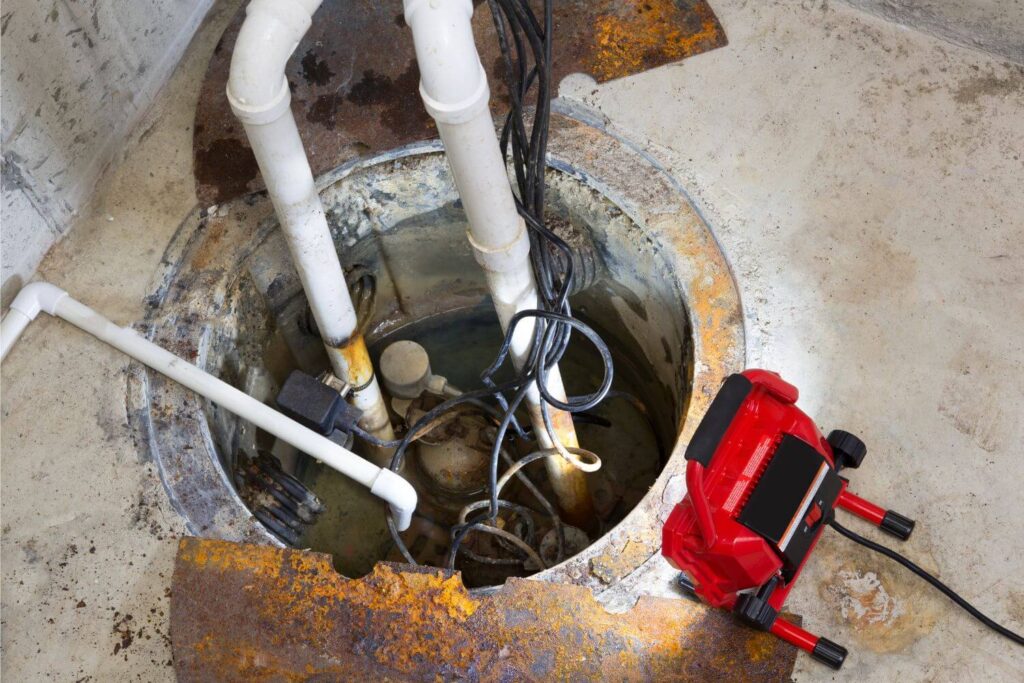A frozen sump pump can lead to an icy flooded basement and property damage. An important part of winter basement waterproofing, preventing frozen sump pump discharge lines and ensuring your sump pump is working properly keeps your home, the property stored in it, and your loved ones safer. Let’s take a look at why your sump system is so important, what you can do to keep it working efficiently all winter long, and when you need to call a basement waterproofing specialist to inspect your property.
Your Sump Pump’s Role in Waterproofing
Your sump pit sits at the lowest point of your basement, where it gathers water and moisture that enters your foundation through seepage, leaks, or the air. Inside this pit, a small but powerful electric pump, usually attached to a sensor that switches it on automatically, works to move water from the pit through your sump pump discharge lines, a network of pipes or hoses that carry the water out of your home and away from the area immediately around the foundation where it can be safely drained.
As the water content of the soil around your home increases, natural drainage may not be sufficient to move it away from your foundation before the increasing pressure begins to push it through joints and cracks. In addition, warm, moist air entering the basement from the heated upstairs portion of the home can condense along the cooler surfaces in the basement. A frozen sump pump prevents active drainage or moisture, allowing it to build up in your basement, a space often used as an additional living area, extra storage, or as a utility room.
Signs Your Sump Needs Help

Before we talk about specific winter basement concerns and the prevention of frozen sump pump discharge lines, it’s important that you can identify when your sump pump may be malfunctioning, damaged, or otherwise in need of service. While these signs are important to recognize year-round, freezing temperatures combined with the moisture from melt, add extra importance this time of year.
- Constantly Running – If your sump pump runs continuously, there could be a problem with the pump, sensor, or discharge lines. It could also point to a larger water infiltration issue that’s putting your foundation at risk.
- Wet Areas – Wet areas could indicate there is a problem with your foundation’s drainage or that your pump isn’t moving water properly.
- Rapid Cycling – Rapid on-off cycling may be a sensor malfunction that requires adjustment or could indicate a larger mechanical issue.
- Out of the Ordinary Odors – Your nose can warn you when something is wrong with your sump pump. A musty, mildew smell indicates water is not being properly drained, while a foul odor could signal a broken or loose sump lid. The acrid ozone smell associated with electric motors could be a sign your pump motor is failing.
Protecting Your Sump During Freezing Weather

Freezing weather presents its own challenges to winter basement waterproofing. Freezing temperatures mixed with precipitation can place additional pressure on your home’s drainage systems both above and below ground. Here are some actionable steps you can take to prevent frozen sump pump discharge pipes and increased soil saturation from putting your property in jeopardy.
- Perform Your Regular Sump Pump Maintenance Before Temperatures Drop – Before winter weather gets into full swing, check your sump pump for proper functioning, ensure the backup power is working, and make any necessary adjustments. It’s far better to find any potential issues now than when your sump pump is already frozen.
- Insulate Discharge Pipes and Hoses – Where possible, install insulation around your discharge pipes and hoses, just as you would around your household pipes. Take special care anywhere they’re otherwise exposed to open air, as the cold wind can cause pipes to freeze up even faster.
- Check Your Grading – Proper grading helps carry rain, sleet, and runoff away from the walls of your foundation, but it can erode over time. Make sure the area around your basement drops at a rate of about one inch every foot for at least 5-10 feet from your home. This helps relieve the pressure against your basement walls in the winter as water is directed away. Discharge lines can also take advantage of this grading, as being laid at a slope lets gravity help keep water moving.
- Protect Your Gutters – Your gutter and downspout system collects water from your roof, guides it to the ground, and then away from your home. Keep your gutters clear and install guards to prevent leaves and other debris from forming clogs to prevent ice dams. Ice dams can cause water to overflow your gutters and fall directly next to the foundation, putting more pressure on your walls and causing your sump pump to work harder.
- Keep It Flowing – Moving water freezes slower than still water. One trick to help prevent a frozen sump pump or discharge lines is intentionally introducing a trickle of water into your sump pit. This adds enough volume to keep the water in your sump system moving, making it less likely to freeze.
Getting a Professional Involved
Whether you have a frozen sump pump or need to talk to a pro about a custom winter basement waterproofing plan, we’re ready to help. We’ve built our reputation by providing professional service with American-made parts backed by a lifetime warranty on our work. Call for your free basement inspection from A.M. Wall Anchor & Waterproofing today.

